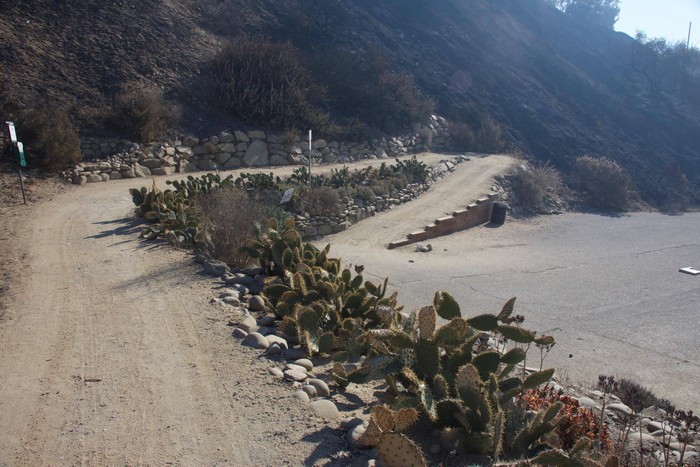“Many plants in the VBG collection have evolved with fire and are adapted to survive fire events.”
by Mary Kay Doubek VBG volunteer
One look at the charred hillside above our still-standing City Hall tells one that Ventura Botanical Gardens (VBG) did not escape the destruction of the Thomas Fire as it swept through town beginning December 4. Despite extensive damage, VBG and The City of Ventura have already reaffirmed their partnership and commitment to deliver on the vision for the gardens. “There will be new challenges, of course,” said Joe Cahill, Executive Director of VBG, “but the aftermath of this devastating wildfire also presents new opportunities. We remain optimistic that our circumstances also have potential to benefit the long-term development of Ventura Botanical Gardens.”
VBG wasted no time, surveying the damage to the gardens soon after the fire was extinguished. Along with the destruction, Cahill reported that most of the skeletal infrastructure is intact. “Starting in 2012, our volunteers, the Conservation Corp, and the City of Ventura steadily added structural support and stone retaining walls to the planting areas and garden trail over a 30 acre area. That newer work held up well, but we will need to do minor repairs and replacement to make the trail safe again for visitors. For example, an old clay drainage pipe collapsed and caused the section of trail above it to cave in. In another section of trail, a 10-foot-long wooden retaining wall burned. Amazingly, the wooden bridge under construction in the Fynbos garden remains untouched, but on the other hand, several new educational signs and plant specimen labels melted.”
VBG has already engaged contractors to proceed with the repairs. Other plans underway include reseeding of the hillsides adjacent to developed garden areas to protect and mitigate erosion from winter rains. Depending on the availability of financial resources, the gardens will utilize technical products, such as fiber coating, in areas with severe or unstable slopes. These are protective and proactive measures the gardens can put to use, if they can be funded.
As far as vegetation is concerned, the worst devastation occurred in areas were where dead brush had built up since the last major fire in Grant Park in 1970. The garden planting areas fared somewhat better, but it will take months to complete the evaluation of the 700 specimen plant collection from Mediterranean climate regions of the world. However there is good reason to be optimistic. According to Cahill, “Many plants in the VBG collection have evolved with fire and are adapted to survive fire events. The main areas already planted in VBG stand in contrast to the old brush areas of Grant Park. The newly planted areas also survived well because volunteers had cleared dead brush so there was a lack of fuel. And since the fire, VBG has been watering the planting areas. Miraculously, some plants already have new leaf buds forming. Time will tell what the ultimate survival rate is, but we are keeping a positive outlook!”
Joe had more good news about the gardens’ water tanks and old stone walls. “The 10,000 gallon water tanks installed two years ago are intact, affording us a great opportunity to accelerate expansion of our irrigation system, and thus, to plant and restore larger areas of the garden. Also, the fire exposed more historic stone walls that were agricultural terraces, perhaps 50 sections of wall. There are also many remnants of an old trail system in the ravine to the west of the existing trail complete with mortared stone steps, mortared stone walls and switchbacks. These newly discovered features may make it more feasible and cost effective to add new trails, by simply rehabilitating very old trails. VBG is working with Sean Anderson from CSCI ESRM field crew GIS group to map these features so they can be incorporated into future planning.
Rosa Lee Measures, one of VBG’s founders has offered these words of hope to all, “With heavy heart, I mourn the losses of so many homes and precious keepsakes, of our dear friends. Grateful their lives were spared, as homes can be rebuilt.”
I fully believe that many of our precious plants will be resurrected, and maybe stronger out of the ashes. Hopefully, rejuvenating the Ventura Botanical Gardens will be therapeutic, and further reunite our community. “It is important to remember that fire is a natural process in California and in other Mediterranean climate regions of the world. It may look devastating, but periodic fire rejuvenates the landscape. Almost always there are spectacular spring wildflowers in the years following a fire and there will be other silver linings for VBG as we continue to develop the garden with support from the community.” said Joe Cahill, executive director of VBG.
The gardens and trail will remain closed while repairs are underway. Please respect the “No trespassing” warnings and wait for the public announcement that VBG is once again safe for visitors. Also, be on the lookout for VBG announcements for additional volunteer days so that the public can help with the recovery effort.

